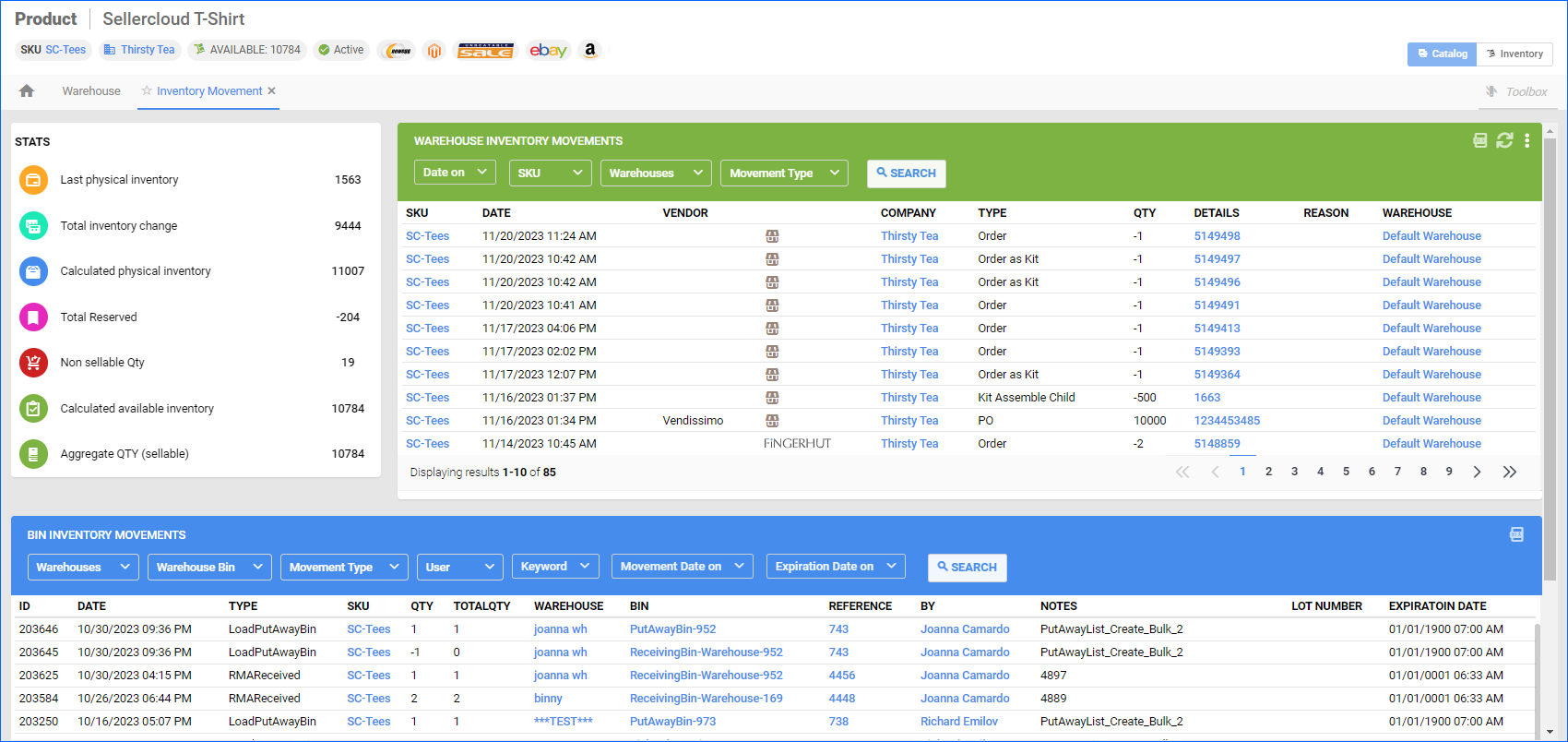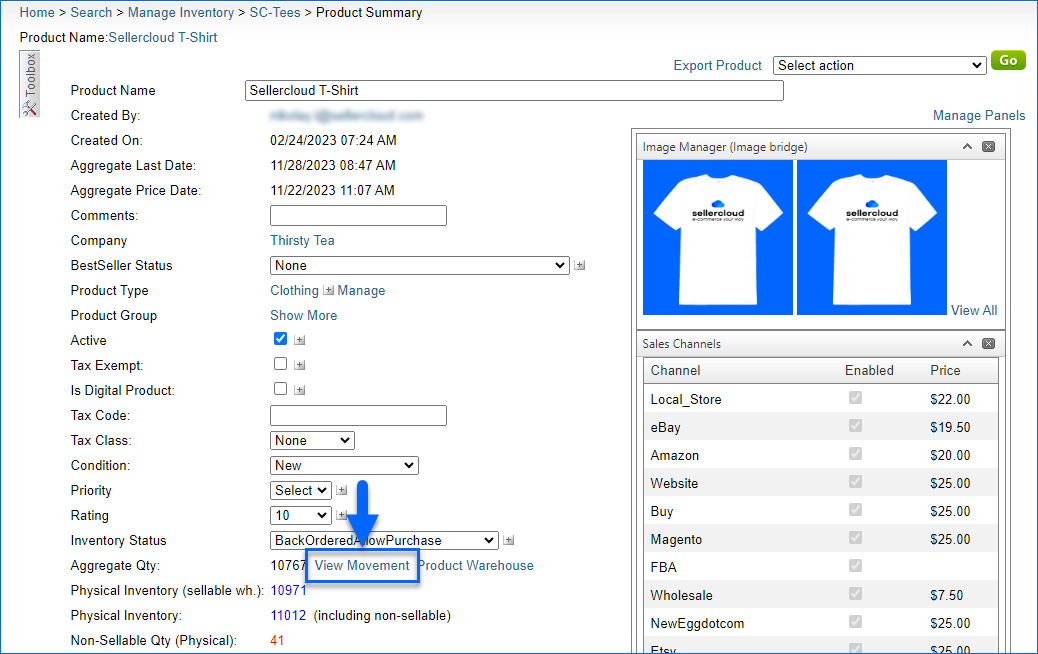Overview
Sellercloud logs all product inventory movements across Warehouses and warehouse Bins in real-time, ensuring that your quantities are always accurate and up to date. You can easily view and even export each product’s complete movement history on its Inventory Movement page. This page also shows detailed statistics related to inventory changes and the currently available and unavailable quantities, all in one place.
View Inventory Movements
To view all recent inventory movement details for a specific product:
- Go to the Product Details Page.
- Click Toolbox and select Inventory Movement.

- There are three panels on the page:
- Stats – Shows the current aggregated inventory data.
- Warehouse Inventory Movements – Shows warehouse movements.
- Bin Inventory Movements – Shows bin movements.
Refer to the following sections for details about each panel.
Stats
| Statistic | Description |
| Last Physical Inventory | The last recorded change in the physical inventory quantities that have been set Manually or In Bulk across all warehouses. For example:
|
| Total Inventory Change | The cumulative change in the product’s inventory caused by Inventory Adjustments, considering all additions and subtractions. For example:
|
| Calculated Physical Inventory | The sum of the Last Physical Inventory and the Total Inventory Change. It shows the final physical inventory across all warehouses after manual physical updates and adjustments. |
| Total Reserved | The quantity of the product Reserved for pending orders or other purposes. |
| Non-Sellable Qty | The quantity of the product stored in Unsellable Warehouses. |
| Calculated Available Inventory | The current quantity available for sale, calculated by subtracting the Total Reserved and Non-Sellable Qty from the Calculated physical inventory. The calculation is based on the movements shown on this page. |
| Aggregate Qty (Sellable) | Same as the above, this is also the combined quantity of the product available for sale. However, this quantity is pre-calculated and stored in the system. |
Warehouse Inventory Movements
You can use the following filters to show only specific movements:
| Filter | Description |
| Date on | Show only movements that occurred within a specific time range. |
| SKU | Show only movements of a specific SKU. If the product has Shadows, you can select them here. |
| Warehouses | Show only movements related to a specific warehouse. |
| Movement Type | Show only specific movement types. |
The panel’s columns show the following data:
| Column | Description |
| SKU | The SKU whose inventory has been moved. |
| Date | The timestamp of the movement. |
| Vendor | The vendor associated with the movement. |
| Company | The company the movement relates to. |
| Type | The movement type (e.g., Order, PO, Inventory Adjustment). |
| Qty | The number of units that have been moved. |
| Details | The ID of the associated entity. |
| Reason | The reason for the movement. |
| Warehouse | The warehouse where inventory has been moved. |
The panel also includes the following actions on the top right:
| Action | Description |
| Export | Export the product’s inventory movement history to an Excel spreadsheet. The spreadsheet includes one column that the user interface doesn’t – the User column, which shows the email address of the user who performed the movement. |
| Recalculate Inventory | Sellercloud automatically runs calculations in the background to adjust inventory based on the current orders, POs, and other events that reserve inventory. With this action, you can run this calculation manually instead of waiting for the automatic calculations to take place. |
| View All Movement | Open the Manage Inventory Movements page, showing all movements associated with the product. |
| View FBA Movement | Opens the Manage Inventory Movements page, showing all FBA Shipment movements of the product. |
| View Available Serials | Opens the product’s Serial Numbers page. |
Bin Inventory Movements
The bin inventory movements panel only has one action on the top right: Export – Exports the product’s bin movement history to an Excel spreadsheet. The spreadsheet includes four columns that the user interface doesn’t:
| Column | Description |
| Warehouse ID | The unique identification number of a warehouse. |
| Bin ID | The unique identification number of a bin. |
| User ID | The unique identification number of a user. |
| Reference URL | The unique URL pointing to the page where the movement occurred. |
You can use the following filters to show specific movements:
| Filter | Description |
| Warehouses | Show only movements related to a specific warehouse. |
| Warehouse Bin | Show only movements related to a specific bin. |
| Movement Type | Show only movements of a specific type. |
| User | Show only movements initiated by a specific user. |
| Keyword | Show only movements with specific text in the ID, Type, Reference or Notes columns. |
| Movement Date on | Show only movements that occurred within a specific time range. |
| Expiration Date on | Show only movements of products whose expiration date is within a specific time range. |
The columns show the following data:
| Column | Description |
| ID | The unique identification number of the inventory movement. |
| Date | The timestamp of the movement. |
| Type | The movement type (e.g., OrderPicked, PutAway, BinTransfer). |
| SKU | The SKU whose inventory has been moved. |
| Qty | The number of units that have been moved. |
| Total Qty | The number of units currently stored in the bin. |
| Warehouse | The warehouse where the bin is located. |
| Bin | The bin involved in the movement. |
| Reference | The ID of the associated entity. |
| By | The user who performed the movement. |
| Notes | Additional information about the movement. |
| Lot Number | The Lot Number of the moved inventory. |
| Expiration Date | The expiration date of the product lot. |
Overview
Sellercloud logs all product inventory movements across Warehouses and warehouse Bins in real-time, ensuring that your quantities are always accurate and up to date. You can easily view and even export each product’s complete movement history on its Inventory Movement page. This page also shows detailed statistics related to inventory changes and the currently available and unavailable quantities, all in one place.
View Inventory Movements
To view all inventory movement details for a specific product:
- Go to the Product Details Page.
- Next to the product’s Aggregate Qty field, click the View Movement link.

- Clicking the link opens the product’s Inventory Movement history page.

- The page consists of four key parts:
- The Links to other pages on top, above the filters and stats.
- The Stats on the right show the current aggregated inventory data.
- The Filters on the left control what the grid below shows.
- The Grid at the bottom shows the movement data since the Last Physical Inventory. You can check the date, channel, type of movement, warehouses, and quantities. Any orders, POs, or Shipments will have a direct link.
Links
The following links are at the top of the page:
| Link | Description |
| Product Warehouse | Shows all warehouses and the current quantities this SKU has in any of them. Here, you can also see all the shadows of this SKU and their quantities. At the bottom of the Product Warehouses page, there are the options to Adjust Inventory, Transfer Inventory, and Set Physical Inventory. |
| View All Movement | See all inventory changes from when this SKU was created, ignoring the Last Physical Inventory. This page is useful for checking older records, but it will not show you the current calculations since they are based on the Last Physical Inventory. |
| View FBA Movement | Opens the FBA Movement page, showing all FBA Shipment movements of the product. |
| View WFS Movement | Opens the WFS Movement page, showing all WFS Shipment movements of the product. |
| View Available Serials | Opens the product’s Serial Numbers page. |
Stats
The following inventory statistics about the product are available on the page:
| Statistic | Description |
| Last Physical Inventory | The last recorded change in the physical inventory quantities that have been set Manually or In Bulk across all warehouses. For example:
|
| Total Inventory Change | The cumulative change in the product’s inventory caused by Inventory Adjustments, considering all additions and subtractions. For example:
|
| Calculated Physical Inventory | The sum of the Last Physical Inventory and the Total Inventory Change. It shows the final physical inventory across all warehouses after manual physical updates and adjustments. |
| Reserved (Unshipped) | The quantity of the product Reserved for pending orders or other purposes. |
| Non-Sellable Qty | The quantity of the product stored in Unsellable Warehouses. |
| Calculated Available Inventory | The current quantity available for sale, calculated by subtracting the Total Reserved and Non-Sellable Qty from the Calculated physical inventory. The calculation is based on the movements shown on this page. |
| Aggregate Qty (Sellable) | Same as the above, this is also the combined quantity of the product available for sale. However, this quantity is pre-calculated and stored in the system. |
Filters
You can apply the following filters to narrow down the results in the grid:
| Filter | Description |
| ProductID | Show only the movements of a specific SKU. If the product has Shadows, you can select them here. |
| Warehouse | Show only movements related to a specific warehouse. |
| Type | Show only specific movement types. |
| Date | Show only movements that occurred within a specific time range. |
Grid
The grid’s columns show the following data:
| Column | Description |
| SKU | The SKU whose inventory has been moved. |
| Date | The timestamp of the movement. |
| Vendor | The vendor associated with the movement. |
| Channel | The channel associated with the movement. |
| Company | The company the movement relates to. |
| Type | The movement type (e.g., Order, PO, Inventory Adjustment). |
| Details | The ID of the associated entity. |
| Qty | The number of units that have been moved. |
| Parent SKU | The parent SKU associated with the movement. |
| Price | The SKU’s price associated with the movement. |
| Cost | The SKU’s cost associated with the movement. |
| Adjustment Reason | The reason for the movement. |
| Warehouse | The warehouse where inventory has been moved. |
The panel also allows you to perform the following actions:
| Action | Description |
| Export | Export the product’s inventory movement history to an Excel spreadsheet. |
| Recalculate Inventory | Sellercloud automatically runs calculations in the background to adjust inventory based on the current orders, POs, and other events that reserve inventory. With this action, you can run the calculation manually. |
| View Reserved Orders | View a list of open orders currently reserving some of the product’s inventory. |